Awesome animals 5 класс план урока
Обновлено: 06.07.2024
Урок представляет собой комплексное применение знаний и навыков при изучении нового материала. В связи с этим в нём присутствуют такие этапы как организационный момент, фонетическая разминка, основная часть (подготовка учащихся к активному усвоению знаний учащихся, усвоение и первичное закрепление новых знаний), информирование о домашнем задании и инструктаж по его выполнению, а также подведение итогов урока. Структура урока была выдержана в соответствии с методическими требованиями.
Цель урока: обобщение изученного материала по теме “Amazing Animals”.
В соответствии с программными требованиями были поставлены следующие задачи урока:
Образовательные:
1) Повторение и закрепление ранее изученных лексических единиц;
2) Закрепление навыков оперирования языковым материалом в устной речи;
3) активизация умений работать в парах, в группах;
4) повторение и закрепление грамматического материала: обобщение темы Present Simple ( образование и употребление );
5) формирование навыков поискового чтения, восприятие и анализ информации.
Воспитательные:
1) формирование коммуникативных навыков;
2) расширение социо- культурной компетенции учащихся;
3) воспитание у учащихся бережного отношения к живым существам;
4) преодоление боязни ошибок и эмоционального барьера.
Для решения образовательных задач учащимся были предложены разнообразные задания, соответствующие уровню данного класса. Учебный материал был отобран из учебника и прилагаемых к нему источников.
Демонстрационный материал: презентация Microsoft PowerPoint и аудиозаписи, применяемые в целях демонстрации аутентичного материала и создания англоязычной атмосферы для повышения интереса учащихся к предложенному аспекту английской литературы.
Раздаточный материал: карточки с заданиями по грамматике, фото с изображением животных.
Методические приемы: демонстративный метод, методы формирования речевых умений (конструирование предложений, тематическая группировка), метод постановки вопросов, элементы аудирования, прием списывания с целью формирования умения правильно писать по-английски, различные приемы активизации внимания школьников.

Teacher: - Good morning, boys and girls. I’m very glad to see you again.
How are you? OK. Let’s start our lesson. Look at the screen and read the following Russian proverbs.

1. Волков бояться - в лес не ходить.
2. Богат Ермошка – есть собака и кошка.
3. Соловья баснями не кормят.
4. За двумя зайцами погонишься – ни одного не поймаешь.
5. И медведя плясать учат.
Teacher: - What is common in all these proverbs?
Pupils: - All of them are about animals.
Teacher: - So what is the topic of our lesson?
Pupils: - Amazing animals.
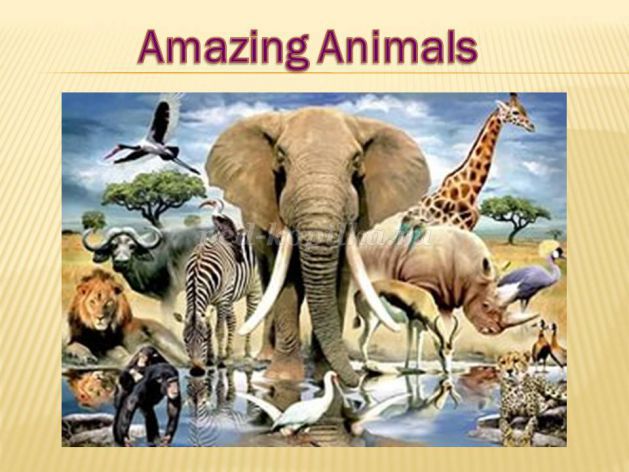
Teacher: - What can you do in English?
1) Can you name the animals in English?
2) Can you describe the animals and their parts of the body?
3) Can you write a fact file about animals?
4) What grammar tense do you use speaking about animals?
5) So what are we going to do at the lesson?
Teacher: - Are you ready to start? Look at the screen. You know that there are three types of animals. What are they?
Pupils: - They are wild, domestic and pets.
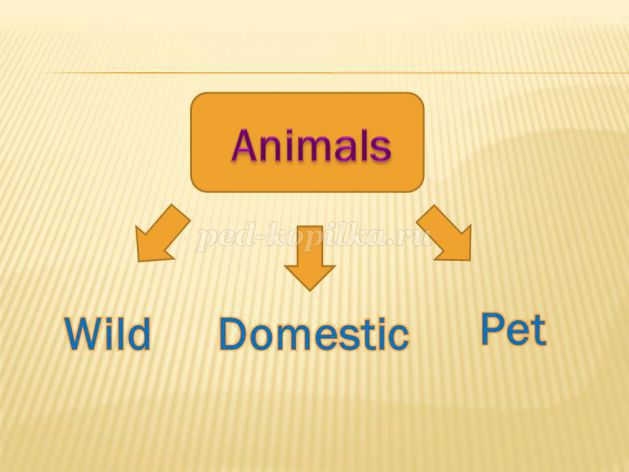
Teacher: - What are wild animals?
Pupil 1: - Wild animals are animals.
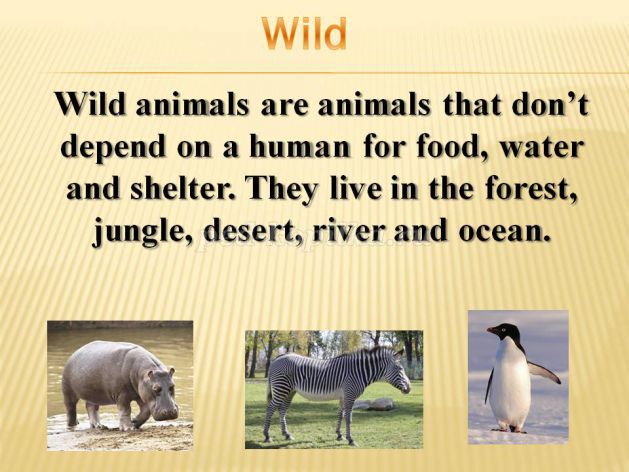
Teacher: - What are domestic animals?
Pupil 2: - Domestic animals are animals.
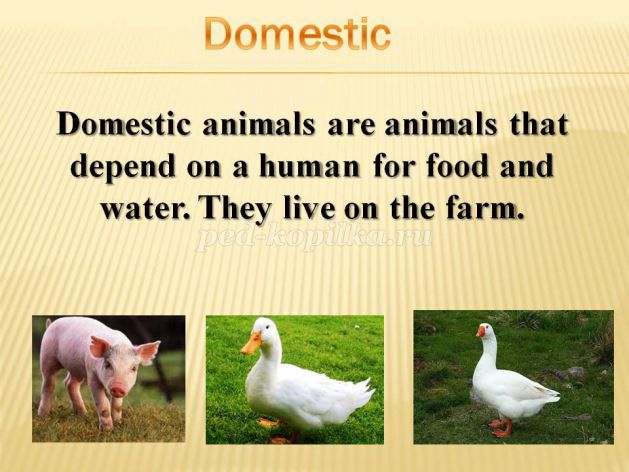
Teacher: - What are pets?
Pupil3: - Pets are animals…
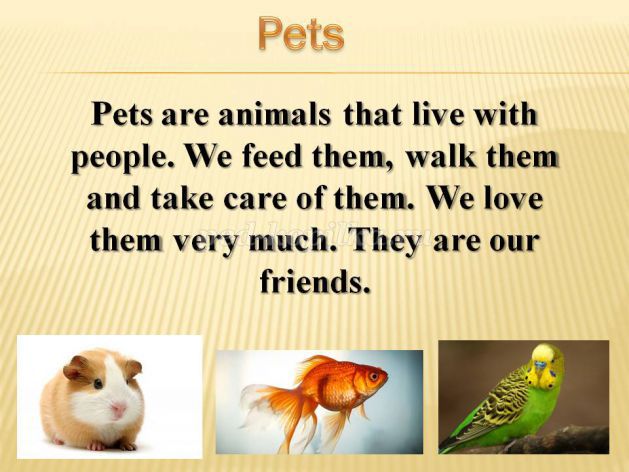
Teacher: - Look at the screen. Which of them are wild animals (domestic, pets)?
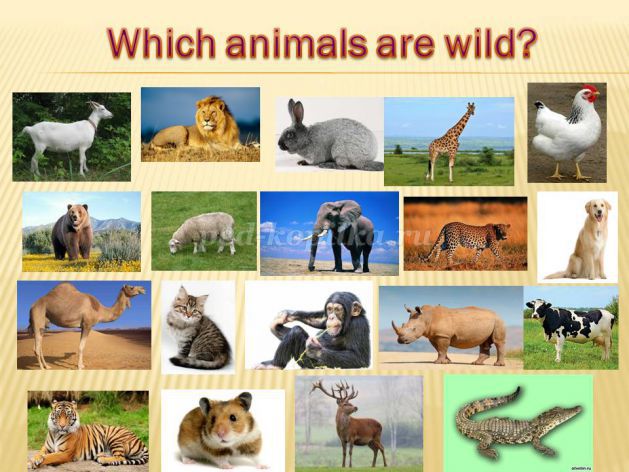
Teacher: - Now match the name of the animals and its description.
1. The animal is timid and shy. Bear
2. The animal is very cunning. Zebra
3. The animal sleeps all winter in a den. Lion
4. The animal can live without food and water for a long time. Fox
5. The animal has beautiful white skin with black stripes. Rabbit
6. The animal has thick mane. Camel
Teacher: - Well done!
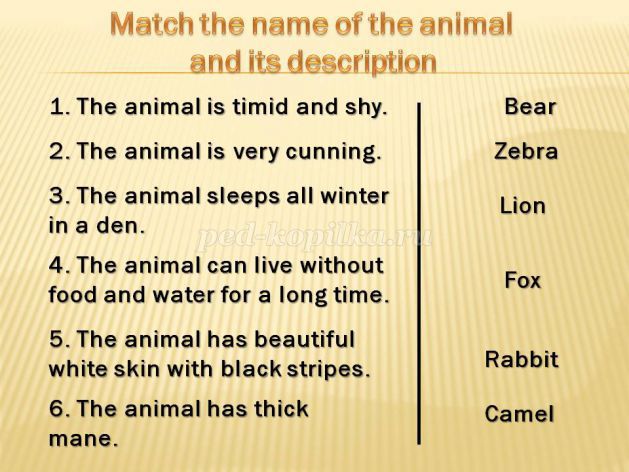
Teacher: - Would you like to know more about animals? Which words can help us to describe animals? Let’s repeat parts of the body.
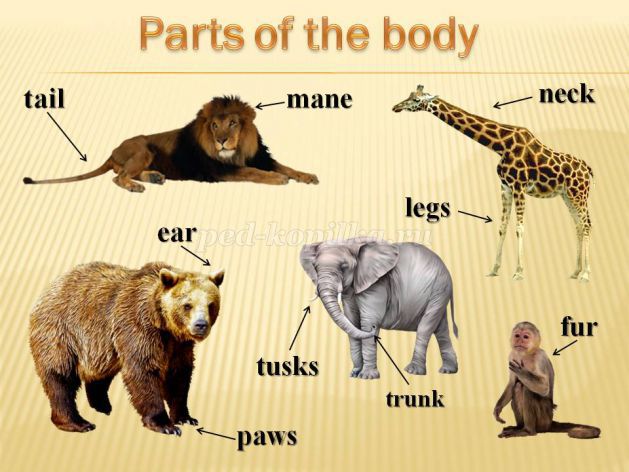
Teacher: - Now listen to me very attentively and try to guess what animal I’m speaking about?
It is a wild animal. It has got a long body, short legs, long tail and sharp teeth. Its skin is smooth and green. It lives in the river. It is very dangerous. What is it? Did you guess?
Teacher: - You have got white envelopes on your desks. There are several pictures of the animals there. Take them out of the envelopes and show me the right picture. What animal is it? That’s right. It is a crocodile.
Teacher: - I hope you like animals. What do they look like? Which animal is your favourite? Look at the blackboard and describe the animal you like using the following key words. (описание животных по картинкам с использованием ключевых слов).
Pupil 1: - This is an elephant. …
Pupil 2: - This is a rabbit. …
Pupil 3: - This is a cat. …

Teacher: - Now it’s high time to speak about the abilities of the animals and the verb can will help us. What can they do and can’t do?
Take green envelopes on your desks. There are some scraps there. Take them out of the envelopes and make up sentences. Work in pairs.
1. The Arabian Camel is an animal of North Africa. It can live without food and water for a long time.
2. The Bengal tiger is the national animal of India. It can hunt big animals.
3. The elephants are very big. strong and friendly. They can’t run fast.
4. The Indian rhino is a funny animal. It likes to sit in water or mud.
5. Brown bears live in the forests. They eat fish, berries and nuts.
6. Koala lives in Australia. It lives in trees and eats leaves.
Teacher: - Well done!
Teacher: - Answer my questions.
1. Do you like bears?
2. What fairy tales do you know about bears?
3. Would you like to know more about bears?
Read the text, try to understand it and then write a fact file.
Animal:
Body:
Colour:
Food:
Home:
(a place where they can spend the winter)
Teacher: - Answer my questions.
1. What is the text about?
2. What do they look like?
3. What colour are they?
4. What do they eat?
5. Where do they spend winter?
Teacher: - For the next lesson write a fact file of your favourite animal. Use a fact file about bears as a model.
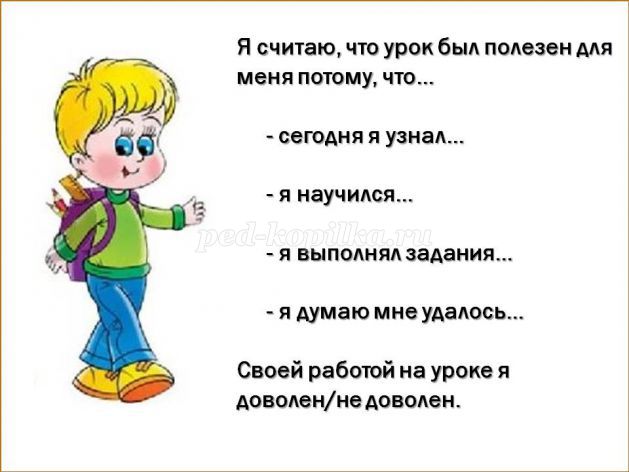

Данная учебно-методическая разработка урока была мною применена на практике, что, в целом, позволило подтвердить положительную значимость выбранной методики проведения урока, а также и частных методов организации процесса ведения урока для более успешной реализации задачи по объяснению материала учащимся.
Каждый этап урока предусматривал свои продуманные методы обучения и формы организации познавательной деятельности, способствовавшие стимуляции активной работы учащихся и увлечению класса, отобранным материалом в соответствии с их возрастными потребностями и интересами и погружение учеников в языковую среду.
Так, учащиеся, с опорой на раздаточный и демонстрационный материал, достаточно активно участвовали в учебном процессе, что позволило им усваивать материал осознанно и прочно, а также попутно происходило развитие интеллектуальных способностей учеников (внимание, память, мышление, воображение, развитие фонематического слуха и языковой догадки), отрабатывались общеучебные умения и навыки (умение работать с текстом, отвечать на поставленные вопросы, подготовить устный ответ), воспитывался не только интерес к предмету, но и трудолюбие, желание проявить себя, умение слушать. При изучении нового материала акцент делался на практические языковые умения и навыки.
Все этапы урока были взаимосвязаны, и каждый логично вытекал из предыдущего. Переход к новому учебному материалу в рамках урока осуществлялся только после того, как предыдущая информация учащимися усваивались в полном объеме. Домашнее задание было подготовлено ходом урока, выбрано с целью закрепления полученных на уроке знаний и введения нового лексического и грамматического материала, и дано с необходимым инструктажом о порядке его выполнения и возможных затруднениях.
В целом атмосфера на уроке была живая и доброжелательная, без неоправданных пауз, ученики работали с интересом и удовольствием. Подведение результатов в конце урока показало высокое качество полученных знаний большинством учащихся, хотя некоторым ребятам необходимо работать на уроке более активно и оперативно. Класс в целом был готов к активной работе на уроке и мобильному выполнению заданий.
Временное соотношение частей урока было выдержано в соответствии с целями урока, все этапы урока были завершены в соответствии с планом. У детей удалось сформировать мотивацию к учебной деятельности на данном уроке, был подобран учебный материал, который смог заинтересовать учащихся. Поставленные цели и задачи урока были достигнуты. Дальнейшие уроки предполагают отработке и закрепление нового лексического и грамматического материала с опорой на домашнее задание.
Свидетельство и скидка на обучение каждому участнику
Зарегистрироваться 15–17 марта 2022 г.
Unit: Living things
Date: 27.04. 2018
Teacher name: Saltanat Seitova
Number present:
Theme of the lesson
Learning objectives(s) that this lesson is contributing to
5.S4 respond with limited flexibility at sentence level to unexpected comments on an increasing range of general and curricular topics
5.R2 understand with little support specific information and detail in short, simple texts on a limited range of general and curricular topics
5.W3 write with support factual descriptions at text level which describe people, places and objects
5.UE1 use appropriate countable and uncountable nouns, including common noun phrases describing times and location, on a limited range of familiar general and curricular topics
Lesson objectives
By the end of the lesson all learners will be able:
to pronounce animals name correctly;
to answer to general questions about animals;
By the end of the lesson most learners will be able to:
to guess parts of the animals on the picture;
to underline new words and explain their meanings;
to find countable and uncountable nouns in the text;
By the end of the lesson some learners will be able:
to make up 10 questions about specific details of the text;
to retell the main points from the text;
Value links
to bring up pupils to protect animals;
to save it to our future generation;
to prepare a quiz about one chosen animal;
to bring up pupils to protect animals;
to save it to our future generation
Cross curricu l ar links
Communicate with biology and geography
Assessment criteria
Identify details in a reading passage with little support
Identify and apply countable and uncountable nouns in the given sentences correctly
Use the information to write sentences which describe people, places and objects
Planned things
Planned activities
Greeting learners. Teacher setting positive atmosphere with learners.
Teacher show them the video with physical exercises to elicit learners’ attentiveness on the lesson.
Activating prior knowledge. Formative assessment.
Activity 1. Cluster.(I) Learners work in a small group or in pairs. Complete the mind map and talk about it. Present your ideas to the group. Listen to the feedback.

Suggested answer: Sun, water, air, love, ground, good weather;
Teacher use phonetic drill to introduce a topic, generate interest of learners. Learners listen attentively and repeat after teacher.
You can go to Africa
To see some chimpanzees
You can see huge rhinos
And giraffes as tall as trees
Travel to Australia
And meet a kangaroo
Or see a scary spider
And a cute koala too
Activity 2: Method 5W questions.: (W)
Teacher asks questions, learners listen and answer. If some learners can’t answer the questions teacher shows them and help with some gestures. Teacher makes discussion around this questions. Teacher checks up learners answer with “ No hands up” method, i. e. mustn’t put up their hands to answer but instead the teacher will select someone to answer at random.
What kind of animals do you know?
Where do wild animals live?
Where do domestic animals live?
When do people use animals?
Which animals are very clever?
Learners are divided into 3 groups using animals puzzles. They mingling around the classroom and gather puzzles like a head. body, leg.
Drilling. Learners repeat after teacher. Use scaffolding i.e. support by showing pictures to learners for their deeper understanding and remembering of words.

Input new vocabulary: wild animals, domestic animals, wolf, Elephant, dolphins, horse, bull, cow, sheep, giraffe, kangaroo, koala, goat, zebra;
Activity 3. Mingling activity: (G)
Learners look at the picture and guess, parts of what animal are on the picture. They distinguish and categories each part of animal’s body and match by gluing up with animals’ pictures.

Activity 4. Read and translate the text: (G)
After reading task:
1 Group. Learners make up 10 questions about specific details of the text;
2 Group. Learners underline new words and explain their meanings;
3 Group. Learners compare wild and domestic animals according to the text by making graphic organizer;
Input new grammatical theme: countable and uncountable nouns. Learners read the example and find differences between two pictures. Then answer the question from the teacher:
How do you think can we count the horse’s mane or our hair?”
Suggested answer: - No
You are right, uncountable nouns are things that we can’t count with numbers.
My horse has a long mane.

Horses like to eat green grass.
Activity 5: Fixing new grammatical theme by sign up countable and uncountable nouns from the text.
Activity 6: Creative work.(G)
Learners create mythical animal and prepare a quiz about it. They use the question below to help to learners.
Свидетельство и скидка на обучение каждому участнику
Зарегистрироваться 15–17 марта 2022 г.
Lesson plan
LESSON: Unit 3 Living things. Awesome animals.
School: №15
Date: 20.10.2017
Teacher name: Kylyshbaeva Bibizhamal
Number present:
Learning objectives(s) that this lesson is contributing to
5.R4 read with some support a limited range of short fiction and non-fiction texts
5.UE9 use simple present and simple past regular and irregular forms to describe routines, habits and states on a limited range of familiar general and curricular topics
5.S6 communicate meaning clearly at sentence level during, pair, group and whole class exchanges
Lesson objectives
All learners will be able to:
name the animals they know
learn at least 3 new words from animal related vocabulary
read and understand main facts about animals
Most learners will be able to:
tell about the animal they read about
Some learners will be able to:
understand most of the language in text about animals
use present simple forms accurately in speaking
Language objectives
Use simple present simple tense, new vocabulary
Value links
Value of environment
Cross curricular links link
Projector or Smart board for presenting a video
Previous learning
Planned timings
Planned activities
Teacher shows a picture on PPT and asks learners: Which word can you spell? ( slide 1 ) Learners should spell the word correctly, then teacher can introduce the topic of the lesson.
Teacher asks learners: What can you see on the picture? (slide 2) Teacher checks their knowledge of how they know the names of some animals.
Then teacher lets the learners know the LO of the lesson. (slide 3)
Teacher starts a word snake on the board using animals, to continue the snake learners have to use the last letter of the following word. (open class activity)
Pre-learning
Learners are divided into small groups and asked to brainstorm and write any animals they know in 2 min and then learners name the animals they have written.
Teacher distributes the handout with animal flashcards and asks learners to match words to the pictures in pairs. ( Differentiation by support, more able learners with learners who need support ). Learners should swap their works with other groups and check each other’s matching worksheets with a teacher’s support. Teacher checks answers as an open-class activity. Teacher focuses on pronunciation and spelling the words correctly. (Peer based assessment)
Teacher divides learners work groups, e.g. kangaroo (student A), tigers (student B), lions (student C)
Teacher introduces the text about animals, for Kangaroo’s group teacher gives the text about Kangaroo, for Tiger’s group, text about Tiger, and for Lion’s text about Lions. Leaners will read in groups, and underline the unfamiliar words and ask each other or teacher can help them. After that, learners should exchange their text with other groups, so learners will read the facts about these three types of animals.
Hot Chair activity.
Teacher takes an empty 3 chairs – one for each team- and puts them in front of the class, facing the team members. Teacher explains to the learners that these chairs are the hot chairs . Then get one member from each team to come up and sit in that chair, so they are facing their teammates, learners should ask questions about animals the learners who sit on the chair. The first hot chair learner to answer the question and wins a point for their team. Teacher monitors, takes notes and assesses learner’s answers. (Teacher based assessment)
To support learners teacher can provide a list of questions on the board as an example:

Краткосрочный план урока по английскому языку по теме "The Living things. Animals." для 5 класса.
Lesson plan
LESSON: Unit 2 Living things. Animals.
School: Donskaya secondary school
Teacher’s name: Yessetova M.S.
Number present:
Learning objectives(s) that this lesson is contributing to
5.R4 read with some support a limited range of short fiction and non-fiction texts
5.UE9 use simple present and simple past regular and irregular forms to describe routines, habits and states on a limited range of familiar general and curricular topics
5.S6 communicate meaning clearly at sentence level during, pair, group and whole class exchanges
Lesson objectives
All learners will be able to:
name the animals they know
learn at least 3 new words from animal related vocabulary
read and understand main facts about animals
Most learners will be able to:
tell about the animal they read about
Some learners will be able to:
understand most of the language in text about animals
use present simple forms accurately in speaking
Language objectives
Use simple present simple tense, new vocabulary
Value links
Value of environment
Cross curricular
Projector or Smart board for presenting a video
Previous learning
Living things. Plants.
Planned timings
Planned activities
Teacher shows a picture on PPT and asks learners: Which word can you spell? (slide 1) Learners should spell the word correctly, then teacher can introduce the topic of the lesson.
Teacher asks learners: What can you see on the picture? (slide 2) Teacher checks their knowledge of how they know the names of some animals.
Then teacher lets the learners know the LO of the lesson. (slide 3)
Teacher starts a word snake on the board using animals, to continue the snake learners have to use the last letter of the following word. (open class activity)
Pre-learning
Learners are divided into small groups and asked to brainstorm and write any animals they know in 2 min and then learners name the animals they have written.
Teacher distributes the handout with animal flashcards and asks learners to match words to the pictures in pairs. (Differentiation by support, more able learners with learners who need support). Learners should swap their works with other groups and check each other’s matching worksheets with a teacher’s support. Teacher checks answers as an open-class activity. Teacher focuses on pronunciation and spelling the words correctly. (Peer based assessment)
Teacher divides learners work groups, e.g. kangaroo (student A), tigers (student B), lions (student C)
Teacher introduces the text about animals, for Kangaroo’s group teacher gives the text about Kangaroo, for Tiger’s group, text about Tiger, and for Lion’s text about Lions. Leaners will read in groups, and underline the unfamiliar words and ask each other or teacher can help them. After that, learners should exchange their text with other groups, so learners will read the facts about these three types of animals.
Hot Chair activity.
Teacher takes an empty 3 chairs – one for each team- and puts them in front of the class, facing the team members. Teacher explains to the learners that these chairs are the hot chairs. Then get one member from each team to come up and sit in that chair, so they are facing their teammates, learners should ask questions about animals the learners who sit on the chair. The first hot chair learner to answer the question and wins a point for their team. Teacher monitors, takes notes and assesses learner’s answers. (Teacher based assessment)
To support learners teacher can provide a list of questions on the board as an example:
1. Where do kangaroos live?
2. What do they eat?
3. How big are they?
Learners complete an evaluation of what they did during the lesson by circling one word in each statement:
I can understand: all / most of / some of the text in the website. .
I can tell about an animal very well/ well/not bad
Additional information
Differentiation – how do you plan to give more support? How do you plan to challenge the more able learners?
Assessment – how are you planning to check learners’ learning?
Cross-curricular links
Health and safety check
ICT links
Values links
More support can be given at the start and in middle of lesson by providing less-able learners with vocabulary in a word list so they can read examples of words seen or heard.
Learners who are less confident at telling about the animal are shown questions to answer
More-able learners can be encouraged to use more complicated sentences
Monitor learners as they read and make notes about the animals. Which learners have difficulties reading, making notes, and reporting information to group orally?
Notice any sentences which are difficult for learners to understand and adapt for a future lesson.
Monitor learners as they prepare the fact file about the animal. Help with the vocabulary
Links to Biology: Do they know about the animals from the websites?
Check if students have a comfortable class layout to work in groups
Learners use computers to locate information, report back to group and record in fact files using some of own words.
Were the lesson objectives/learning objectives realistic?
What did the learners learn today?
What was the learning atmosphere like?
Did my planned differentiation work well?
Did I stick to timings? What changes did I make from my plan and why?
Use the space below to reflect on your lesson. Answer the most relevant questions from the box on the left about your lesson.
Summary evaluation
What two things went really well (consider both teaching and learning)?
What two things would have improved the lesson (consider both teaching and learning)?
What have I learned from this lesson about the class or individuals that will inform my next lesson?
Читайте также:

